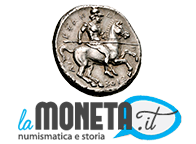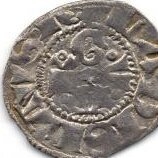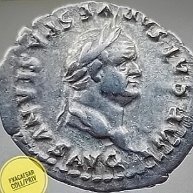Tutte le attività
Questo elenco si aggiorna automaticamente
- Ultima ora
-

Raccolta di rebus attinenti alla Numismatica
apollonia ha risposto a un topic di apollonia inviato in Agorà
Altrettanto, apollonia -
enryco si è registrato sul forum
-
Ciao! Cancro del metallo permettendo la classificherei come MB/q.BB
-
NEWS IPZS 2025
aldo marchesi ha risposto a un topic di Ludovico Volpetti inviato in Euro Monete da collezione Italiane e delle altre Zecche Europee.
Ma che fine ha fatto il 5€ proof AG 2025 100 anni intelligence nel sito della zecca non c'è più. - Oggi
-
 rita.dellerba si è registrato sul forum
rita.dellerba si è registrato sul forum -

10 centesimi V.E.III° cinquantenario 1911 "parzialmente rosso"
fatantony ha risposto a un topic di Alan Sinclair inviato in Regno D'Italia: approfondimenti
Entrambi gli esemplari di II conio mi sembrano in conservazione medio-alta, con la seconda più patinata. Mi unisco alla richiesta di poter vedere i rovesci 😁 -

Monete di Novellara ancora in prima pagina
CdC ha risposto a un topic di mariov60 inviato in Monete Moderne di Zecche Italiane
Ho unito le due discussioni aperte sullo stesso argomento da @Gordonacci @mariov60 -
Anche i caratteri delle lettere sembrano " strani "
-
Salve a tutti. Girando sul web ho visto che parecchie sono le varianti di un piccolo bronzo di Kypsela, Tracia, con Hermes al dritto e vaso con manici al rovescio. Non ne ho trovate però con lettere retrograde come in questo caso, diametro mm. 13, peso gr 1,64. Possibile qualche gradita indicazione ?... grazie
-
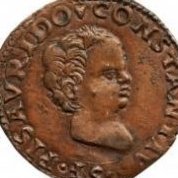
Centesimo 1806 Napoleone Imperatore e Re d'Italia
favaldar ha risposto a un topic di Carlo. inviato in Monetazione degli Stati Preunitari (1800-1860)
Ci sono periti che meritano rispetto, come quelli citati sopra. C'è e c'è stato un cambio generazionale molti stimatissimi ci hanno lasciato in questi ultimi 10 anni (RIP) ma sicuramente le nuove leve si stanno facendo l'ossa e questo ricade anche sui nuovi e "vecchi" collezionisti o semplici Numismatici, siamo una sorta di cavie. Con l'entrata di internet nel Mondo si è allargato tutto a dismisura ora ci sarà d'aspettare che l'evoluzione possa scremare il tutto sperando che riemergano nuovi bravi Maestri.🙏🏼 -
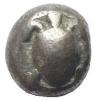
Catalogo Sotheby's Zurich, 26 Oct. 1993
Matteo91 ha risposto a un topic di Matteo91 inviato in Bibliografia numismatica, riviste e novita' editoriali
Grazie mille @legionario Ho provato a scrivere al museo di Monaco per chiedere delle immagini migliori rispetto a quelle tratte dal Kraay... speravo di trovare la moneta nel loro catalogo online, ma mi pare non ci sia... -
Bohhhh... ci hanno messo per caso della cera per lucidarlo? A parte questo, ci sono dei particolari nella leggenda ed anche nella figura del rovescio che ad istinto non mi tornano. Sbaglierò alla grande, ma non la vorrei nemmeno a regalo.
-

BUSTE PRIMO GIORNO ITALIA
Gordonacci ha risposto a un topic di Gordonacci inviato in Filatelia e Storia Postale
-

Identificazione moneta
antvwaIa ha risposto a un topic di Alberto. inviato in Richiesta Identificazione/valutazione/autenticità
Direi proprio di sì, confermando Tessalonica, ma forse riconiato su un altro tertarteron... Trovo molta difficoltà per postare sul forum: forse perché uso Chrome? Dal telefonino mi chiede di usare Edge... -
Ho fatto tanti sacrifici! Ma alla fine ce l'ho fatta! Finalmente ho preso la tanto ricercata ed apprezzata "cappellone" o "elmetto" guardate che profilo! Che mento! Pare uscito da un film di gladiatori! sicuro che non ti abbiano dato una sola? Ma hai vistol'altro lato?!? dipende cosa si intende per "moneta con l'elmetto" ebbè... questa ne ha uno, non c'é dubbio! 🤣 L'altro lato non si vede, che è incollata su di una lattina di tonno e visto che ho paura di rovinarla staccandola, la faccio slabbare così com'è! col tonno io ci fare un buon sughetto alla panna per i fusilli non saprei, sulla scatoletta c'è scritto quacosa in tedesco e sembra scadesse nel 1918. ormai è tradizione chiudere così:
-

Due dracme sassanidi.
antvwaIa ha risposto a un topic di antvwaIa inviato in Altre monete antiche fino al medioevo
Pienamente d'accordo con quanto scrive Robert Tye, ma le misure tratte da monete circolate e quindi più o meno usurate, consentono di dedurre il peso nominale in assenza di usura solamente tramite un'analisi statistica che feci a suo tempo per le monete siracusane del V secolo -
Ciao Nino, non è facile trovarne uno in "altrettanto stato di conservazione" perché sono tutti molto consunti dalla circolazione ed i particolari sono molto appiattiti. Penso servirebbe a poco come paragone 🙂.Un denario che nel suo complesso, tra cui anche lo stile soprattutto del rovescio, lascia parecchi dubbi. Restiamo in attesa. ANTONIO
-
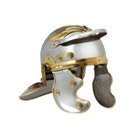
Catalogo Sotheby's Zurich, 26 Oct. 1993
legionario ha risposto a un topic di Matteo91 inviato in Bibliografia numismatica, riviste e novita' editoriali
Sotheby's 26 ottobre 1993 lotto 57 Nelle tavole a colori è presente solo il dritto della moneta. -
 Vicetia si è registrato sul forum
Vicetia si è registrato sul forum -
Chi ha coniato gli ultimi follis?
numa numa ha risposto a un topic di modulo_largo inviato in Monete Bizantine
Caro Modulo la monetazione bizantina e’ tra le meno facili metrologicamente. Molte sono tuttora le questioni irrisolte e in particolare il tetarteron e’ uno dei nominali piu’ sfuggenti. Ti riporto qui sotto un post dedicato proprio a tale tema che ti potra’ dare molte informazioni al riguardo di tale nominale. Perle tue domande, che attengono piu’ a questioni monetarie che non elettivamente numismatiche la migliore fonte e’ l’opera di Michael Hendy che ti ho citato sopra e anche David Metcalf, straordinario studioso di numismatica bizantina purtroppo appena scomparso. Ottimi quesiti i tuoi! With the name Tetarteron, the confusion starts. We have one Eastern Roman (Byzantine) coin name that over a period of centuries represented several denominations all in different levels of the monetary system. An EF Alexius I Comnenus City Tetarteron SBCV-1920 Originally a Tetarteron was a gold coin (Mid 10th and 11th century), then it became a pure silver coin(Early reign of Alexius I) and after the coin reform of Alexius I Comnenus in 1092 it became at least three different lower end denominations. The 12th century coin reform was a focus ofnumismatist Michael Hendy, he saw enough documents that the small copper coins verbally proved they went by the name tetarteron, the same name used as the two previous higher value coins. In previous numismatic books written before his 1969 book these coins were listed a follis or small flat coin. Why the reptation in name for multiple denominations is uncertain, all of the denomination are roughly the same size and shape, In the early 1970s D. M Metcalf did a metallurgy study of Alexius post reform tetartera, he found the ones minted in the city of Constantinople had a silver content of roughly 4%. The Thessalonica minted coins had no silver. That 4% does not sound like much, but a trachy of the same time period had only 8% silver. Alexius I Comnenus Billion Aspron Trachy SBCV-1918 The Alexius I Comnenus reform was the first coinage to use mixed metals, so the fact he made a mixed metal tetarteron is quite logical. The abundance of the coinage from this century marks a turning point in the history of commerce. Michael Hendy included his findings in Dumbarton Oakes Catalog IV published in 1999, the difference in the addition of silver and decided it was a separate denomination from the Thessalonica issues that proved to contain no silver. In his findings he called them the Metropolitain tetartera. A simpler name would have been City Tetartera and for the sake of this article I will refer to them as such. These City tetartera minted in Constantinople were considered extremely rare to find, so hard to find that Phillip Grierson decided they were issued forceremonial use only. At the writing of his catalog the silver content was unknown. Today they do hit the market with some regularity but still far rarer than their Thessalonica counterparts. The Existence of City Tetarteron makes this field even more confusing for the common collector, it no longer looks visible different than those issued in Thessalonica. For the collector the easiest way to know is by looking at the catalog and knowing where it was minted. None of the catalogs that are mainly used today were updated after David Sears Byzantine coins and their values, that is why this is not commonly known among collectors. Now Alexius Issued 4 City Tetartera minted in Constantinople and all with silver content. Here are the four issues, in the most condition found. Dark and no silver wash left. SBCV-1920-1921-1922-1923 As for the most common question, how did the citizens know the difference? After studying this denomination, the last two decades, I noticed sever examples had traces of silver coating, as much as the same way the trachea was silvered so was the City tetartera. The more I handled these coins the less apparent the silvering remained; I was in fact by touching them helping remove the small amount of silvering that was left. The main reason this is no longer noticeable to the collector is that these coins remained in circulation for many years, whatever silver coating was on them long wore off. The tetarteron was too low a denomination to recall for the new ruler. Hoard evidence has proven that coins of Alexius and Manuel were imitated in the 13th century, rulers who had not been around in over 50 years had local population recreating the coins they were familiar with, that in turn tells us they were not recalled. What was the buying power of the coins? in an interesting correspondence between a Princess and her Tutor they buying power was mentioned, In the letter from Thessalonica a tetarteron could purchase a small loaf of bread, the letter from Constantinople mentioned a tetarteron could purchase 12 mackerel fish, A considerable difference between the two denominations so they were defiantly talking about two different coins with the same name. Why are they rarer than the Thessalonica issues? Several reason, they were worth more so, lost less, the circulation of the City tetartera was primarily limited to the city, in the Greek area of the empire, they are rarely found. This is true for all of the rulers who issued City tetartera, they are normally rarer to come to market. Alexius Comnenus I had 4 issues City Tetartera John Comnenus II 2 issues City Tetartera Manuel Comnenus 4 issues City Tetartera Andronicus Comnenus 1 issue of a City Tetarteron. Isaac Angelus II one issue of City tetarteron but with very low silver content around 1% (Isaac Comnenus Usurper of Cyprus tetartera followed the city tetartera with 1.5% silver in all his tetartera, he had 8 issues) Alexius III, one issue and a half tetarteron as well (The only half tetartera known to be minted in the city.), These coins were never tested for silver content and more than likely did not have any. His other mixed metal coin coinage was heavily debased, some of his Electrum Aspron Trachea did not contain any gold.) The tetarteron continued after the fall of Constantinople to the Latins, they change the name in later years to Assarion due to one document found. None of the tetartera after 1203 contained silver even if created in the mint of Constantinople. It once again became a simple copper coin. In the last few years, I have managed to acquire three examples of Alexius City tetartera with silvering intact and one John II City tetartera with some silvering still intact, none are my most attractive examples, two of them seem to be silvered but had a higher silver content allowing them to survive even with heavy circulation. Alexius SBCV-1920 SBCV-1922 Bottom SBCV-1923 and John II Comnenus SBCV-1946 The city tetarteron was a different denomination, The evidence is in DOC IV, Julian Bakers book mentions it but his book was based on 13th century coinage did not go into great detail. He does go into great detail over the imitation tetartera of that century. Other references would include D.M Metcalf and Pagona Papadopoulou. Regardless, collectors and dealers of coins focus on David Sears work and that has not been updated in 50 years and is doubtful that it will be. So hopefully the next major reference work will include All of the new findings of the past 50 years and City Tetartera. Comments appreciated, feel free to dispute, the silver content is well documented, but the silvering is not. Simon (BenSi on the other board.) -

Filatelia Nuove emissioni filateliche Italia
ART ha risposto a un topic di PostOffice inviato in Filatelia e Storia Postale
A parte le motivazioni già espresse fin'ora andrebbe anche detto che sotto il titolo generale di "eccellenze" italiane degne di essere celebrate/commemorate si fa passare con molta fantasia - e a volte direi anche con molta faccia tosta - un po' di tutto (dalle pensiline delle stazioni ai bagnoschiuma, mi piace sempre citare, passando per discutibili personalità), quindi ci può stare anche un personaggio di fantasia ma molto amato da intere generazioni di (ex-)giovani com'è Goldrake. Il ministro o chi per lui non ha tutti i torti, ma non devi stupirti di questo: come Babylon ha già spiegato bene, Goldrake è entrato nell'immaginario collettivo non solo italiano quale pietra miliare che ha segnato il cambiamento generale della postura di un'intera generazione (la mia ma anche altre) nei confronti del fumetto e del cartone animato, opere che - va ricordato - non sono destinate esclusivamente ai piccoli o ai giovani. In molti lo ricordiamo con gran piacere e nostalgia per tutto il divertimento e a suo modo anche gli insegnamenti che ci ha dato. E' un discorso che si potrebbe fare, coi dovuti distinguo, anche per le opere del cinema. -
Salve Antonio,puoi metterne accanto uno simile,mi sembra troppo strano nei campi,la mano e la testa della figura al rovescio
-
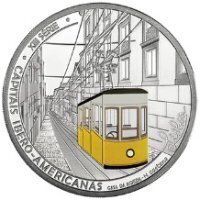
Monete di grosso modulo in rame
Carlo. ha risposto a un topic di spartacus89 inviato in La piazzetta del numismatico
Si lo so.. ma non era per vantarmi, solo per dire che cercando bene si trovano anche belle occasioni! Era un incoraggiamento! 😀 -
grazio72 ha iniziato a seguire Antonino1951
-

BUSTE PRIMO GIORNO ITALIA
Gordonacci ha risposto a un topic di Gordonacci inviato in Filatelia e Storia Postale
-
grazio72 ha iniziato a seguire dux-sab
-

Peso monetale
grazio72 ha risposto a un topic di grazio72 inviato in Richiesta Identificazione/valutazione/autenticità
Due doppie spagnolo......giusto????/ -
Raccolta di rebus attinenti alla Numismatica
Raz Ione ha risposto a un topic di apollonia inviato in Agorà
Lava G NA cancellata Lavagna cancellata Buona serata -
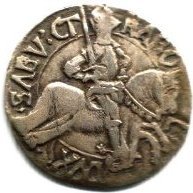
Peso monetale
dux-sab ha risposto a un topic di grazio72 inviato in Richiesta Identificazione/valutazione/autenticità
due doppie.
Lamoneta.it
Il network
Hai bisogno di aiuto?
